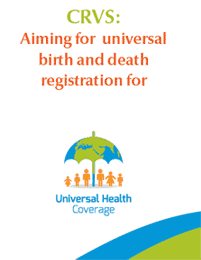
About civil registration and vital statistics systems
A civil registration and vital statistics (CRVS) system is a multisectoral system authorized to register the population’s vital events – such as births, marriages, deaths and causes of death. It does so in a comprehensive, universal, confidential and compulsory manner.
A well-functioning CRVS system is easy to access, hosted on an adequate and secure platform and has an up-to-date legal framework. It is controlled by trained health workforce and registrars, with ongoing data quality checks and system performance monitoring. Annual vital statistics reports are produced and published based on data entered into the system.
Visit the United Nations Statistics Division website to view standards and methods on demographic and social statistics – civil registration and vital statistics.
Eastern Mediterranean Region CRVS assessment
Civil registration systems are used to record vital events, including births, deaths, and marriages. They have the potential to serve as the main source of national vital statistics. However, in many developing countries, civil registration and vital statistics systems are weak or nonexistent; as a result, key demographic, fertility and mortality statistics are not available on a continuous basis and do not cover large segments of the population.



